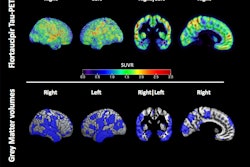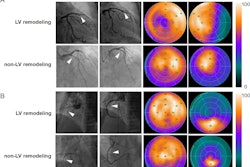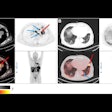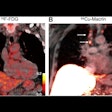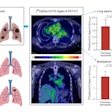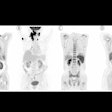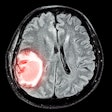Dear AuntMinnie Member,
Tau PET is widely used for identifying patients with suspected Alzheimer’s disease. But can the scans identify people at risk of other tauopathies, like chronic traumatic encephalopathy? A group at the University Toronto in Ontario, Canada, explored this question, with details of the study available here.
Another tool for assessing Alzheimer's disease, amyloid PET, revealed recently that individuals with mothers with a history of memory impairment had higher levels of amyloid plaque, a finding with broad clinical implications, according to the study authors.
In other coverage, PET/MRI may be living up to its hype, with one recent study showing it is superior to PET/CT in cancer patients and another shedding light on neurobiology in young women with autism spectrum disorder.
Additionally, a team at the University of Zurich in Switzerland produced the first 3D image of a patient based on a standard clinical F-18 FDG-PET/MRI scan.
PET/CT nonetheless continues to lead in cancer diagnosis and management, as we discussed in these stories:
- FDG-PET/CT imaging can reduce unnecessary surgeries to remove residual neck cancer in patients who have undergone chemoradiotherapy, according to a group in the Netherlands.
- A phase III trial in France found that F-18 fluorocholine (FCH) PET/CT could be a first-line technique over technetium-99m sestamibi (Tc-99m MIBI) SPECT/CT for imaging parathyroid tumors prior to surgery.
- A group at Johns Hopkins University School of Medicine in Baltimore, MD, found that prostate specific membrane antigen (PSMA)-PET/CT could be an alternative approach for diagnosing patients with renal cell carcinoma.
Plus, we continued our in-depth series on theranostics. In part 2, we asked leaders in the field to discuss what to know before branching into prostate cancer theranostics; in part 3, experts discussed developing freestanding theranostics centers; and in part 4, we noted the concept of women's theranostics appears to be on the horizon. Part 5 featured advice from theranostics center administrators.
Finally, in case you missed any of our coverage last month of the Society for Nuclear Medicine and Molecular Imaging (SNMMI) annual meeting in Toronto, check out our RadCast Roundup in which we posted the top 14 most popular stories from the meeting.
That’s all for now. For more molecular imaging news, be sure to check in regularly with our Molecular Imaging content area.





